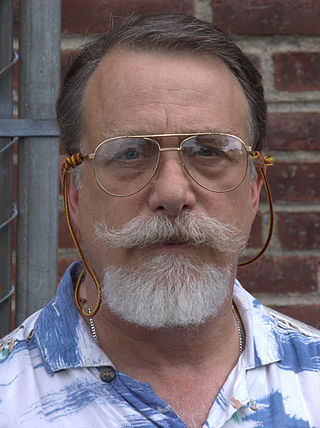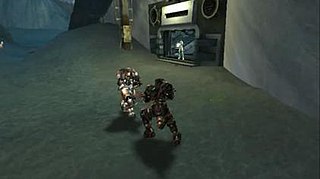
Artificial intelligence (AI) is the intelligence of machines or software, as opposed to the intelligence of humans or animals. It is a field of study in computer science which develops and studies intelligent machines. Such machines may be called AIs.
Alpha–beta pruning is a search algorithm that seeks to decrease the number of nodes that are evaluated by the minimax algorithm in its search tree. It is an adversarial search algorithm used commonly for machine playing of two-player combinatorial games. It stops evaluating a move when at least one possibility has been found that proves the move to be worse than a previously examined move. Such moves need not be evaluated further. When applied to a standard minimax tree, it returns the same move as minimax would, but prunes away branches that cannot possibly influence the final decision.
The Loebner Prize was an annual competition in artificial intelligence that awarded prizes to the computer programs considered by the judges to be the most human-like. The prize is reported as defunct since 2020. The format of the competition was that of a standard Turing test. In each round, a human judge simultaneously held textual conversations with a computer program and a human being via computer. Based upon the responses, the judge would attempt to determine which was which.
"Computing Machinery and Intelligence" is a seminal paper written by Alan Turing on the topic of artificial intelligence. The paper, published in 1950 in Mind, was the first to introduce his concept of what is now known as the Turing test to the general public.

Hugh Loebner was an American inventor and social activist, who was notable for sponsoring the Loebner Prize, an embodiment of the Turing test. Loebner held six United States Patents, and was also an outspoken advocate for the decriminalization of prostitution.
Jabberwacky is a chatterbot created by British programmer Rollo Carpenter. Its stated aim is to "simulate natural human chat in an interesting, entertaining and humorous manner". It is an early attempt at creating an artificial intelligence through human interaction.
In video games, artificial intelligence (AI) is used to generate responsive, adaptive or intelligent behaviors primarily in non-playable characters (NPCs) similar to human-like intelligence. Artificial intelligence has been an integral part of video games since their inception in the 1950s. AI in video games is a distinct subfield and differs from academic AI. It serves to improve the game-player experience rather than machine learning or decision making. During the golden age of arcade video games the idea of AI opponents was largely popularized in the form of graduated difficulty levels, distinct movement patterns, and in-game events dependent on the player's input. Modern games often implement existing techniques such as pathfinding and decision trees to guide the actions of NPCs. AI is often used in mechanisms which are not immediately visible to the user, such as data mining and procedural-content generation.

Robby Garner is an American natural language programmer and software developer. He won the 1998 and 1999 Loebner Prize contests with the program called Albert One. He is listed in the 2001 Guinness Book of World Records as having written the "most human" computer program.

The philosophy of artificial intelligence is a branch of the philosophy of mind and the philosophy of computer science that explores artificial intelligence and its implications for knowledge and understanding of intelligence, ethics, consciousness, epistemology, and free will. Furthermore, the technology is concerned with the creation of artificial animals or artificial people so the discipline is of considerable interest to philosophers. These factors contributed to the emergence of the philosophy of artificial intelligence.
A.L.I.C.E., also referred to as Alicebot, or simply Alice, is a natural language processing chatterbot—a program that engages in a conversation with a human by applying some heuristical pattern matching rules to the human's input. It was inspired by Joseph Weizenbaum's classical ELIZA program.
The minimum intelligent signal test, or MIST, is a variation of the Turing test proposed by Chris McKinstry in which only boolean answers may be given to questions. The purpose of such a test is to provide a quantitative statistical measure of humanness, which may subsequently be used to optimize the performance of artificial intelligence systems intended to imitate human responses.

Quiescence search is an algorithm typically used to extend search at unstable nodes in minimax game trees in game-playing computer programs. It is an extension of the evaluation function to defer evaluation until the position is stable enough to be evaluated statically, that is, without considering the history of the position or future moves from the position. It mitigates the effect of the horizon problem faced by AI engines for various games like chess and Go.
There are a number of competitions and prizes to promote research in artificial intelligence.
Kenneth Mark Colby was an American psychiatrist dedicated to the theory and application of computer science and artificial intelligence to psychiatry. Colby was a pioneer in the development of computer technology as a tool to try to understand cognitive functions and to assist both patients and doctors in the treatment process. He is perhaps best known for the development of a computer program called PARRY, which mimicked a person with paranoid schizophrenia and could "converse" with others. PARRY sparked serious debate about the possibility and nature of machine intelligence.

The computer game bot Turing test is a variant of the Turing test, where a human judge viewing and interacting with a virtual world must distinguish between other humans and video game bots, both interacting with the same virtual world. This variant was first proposed in 2008 by Associate Professor Philip Hingston of Edith Cowan University, and implemented through a tournament called the 2K BotPrize.
Eugene Goostman is a chatbot that some regard as having passed the Turing test, a test of a computer's ability to communicate indistinguishably from a human. Developed in Saint Petersburg in 2001 by a group of three programmers, the Russian-born Vladimir Veselov, Ukrainian-born Eugene Demchenko, and Russian-born Sergey Ulasen, Goostman is portrayed as a 13-year-old Ukrainian boy—characteristics that are intended to induce forgiveness in those with whom it interacts for its grammatical errors and lack of general knowledge.

The Turing test, originally called the imitation game by Alan Turing in 1950, is a test of a machine's ability to exhibit intelligent behaviour equivalent to, or indistinguishable from, that of a human. Turing proposed that a human evaluator would judge natural language conversations between a human and a machine designed to generate human-like responses. The evaluator would be aware that one of the two partners in conversation was a machine, and all participants would be separated from one another. The conversation would be limited to a text-only channel, such as a computer keyboard and screen, so the result would not depend on the machine's ability to render words as speech. If the evaluator could not reliably tell the machine from the human, the machine would be said to have passed the test. The test results would not depend on the machine's ability to give correct answers to questions, only on how closely its answers resembled those a human would give. Since the Turing test is a test of indistinguishability in performance capacity, the verbal version generalizes naturally to all of human performance capacity, verbal as well as nonverbal (robotic).
The Winograd schema challenge (WSC) is a test of machine intelligence proposed in 2012 by Hector Levesque, a computer scientist at the University of Toronto. Designed to be an improvement on the Turing test, it is a multiple-choice test that employs questions of a very specific structure: they are instances of what are called Winograd schemas, named after Terry Winograd, professor of computer science at Stanford University.

Turochamp is a chess program developed by Alan Turing and David Champernowne in 1948. It was created as part of research by the pair into computer science and machine learning. Turochamp is capable of playing an entire chess game against a human player at a low level of play by calculating all potential moves and all potential player moves in response, as well as some further moves it deems considerable. It then assigns point values to each game state, and selects the move resulting in the highest point value.





